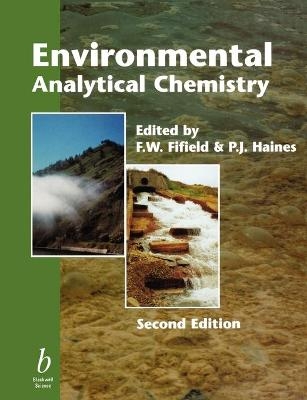
Environmental Analytical Chemistry
Wiley-Blackwell (Verlag)
978-0-632-05383-4 (ISBN)
The first edition of this book established a niche as the only volume with a wide ranging review of analytical chemistry having a focus specific to environmental science. This new edition has been thoroughly revised to take full account of the rapid changes and development in the field over the past five years. Separation science, atomic spectroscopy and speciation determinations are areas in which significant developments have been made, and these are reflected in the new edition. The importance of the assessment of the effects of pollutants on real systems has been recognised by the restructuring of the chapter on biological testing and incorporation of a new one on environmental toxicology. Self-assessment questions have been added.
Environmental science was one of the key concerns of the latter part of the twentieth century and will continue to be into the twenty-first. Concerns for environmental protection and public health worldwide have led to extensive legislation. The investigation and modelling of environmental systems, together with the implementation of laws and regulations, has led to a demand for a large number of environmental measurements, many of which are made by techniques falling within the broad range of analytical chemistry. Many professionals make regular use of data obtained by techniques of analytical chemistry. Thus, although not primarily analytical chemists or even chemists, they need sufficient knowledge of the background of analytical chemistry to judge the quality and limitations of the environmental data obtained. Very much the same situation arises in the academic world, where students are involved in environmental science studies or projects in which they need appropriate analytical chemistry information.
Both analytical chemistry and environmental science have an extensive literature at varying levels of sophistication. However, there have been few attempts to link the two. This book sets out the background to analytical chemistry and covers the principles of its most important techniques. This is done in a way that enables a user to grasp the strengths and weaknesses of a technique, together with its principles of operation, without becoming enmeshed in the chemical small print. Links to environmental uses are indicated in broad terms and then exemplified in more detail by accounts of specific and important environmental problems.
Written for students of chemistry, environmental science and related disciplines, the book is also an essential reference source for those who use environmental information and need to be aware of the factors affecting its quality and reliability.
This is still the only book to focus exclusively on the analytical chemistry methods relevant to environmental studies.
As useful to chemists as it is to non-specialists who require an understanding of the techniques employed to collect data in their disciplines (e.g. environmental researchers, ecotoxicologists, etc).
F.W. Fifield is a former Principal Lecturer in Analytical Chemistry in the School of Applied Chemistry at Kingston University, UK, and now works in association with The Centre for Earth and Environmental Science Research at Kingston. His current research interests concern mainly the environmental problems of the former Soviet Union including Belarus and especially the Irkutsk/Baikal Region of Eastern Siberia. P.J. Haines taught physical and analytical chemistry at Kingston University for thirty years. His research interests include the uses of thermal analysis and spectroscopic methods especially in the area of fire- retardant polymers. He now works as an analytical chemistry consultant.
Contributors v
Preface to First Edition xvii
Preface to Second Edition xix
Part I: General Principles and Techniques 1
1 Introduction 3
F. W. Fifield and P. J. Haines
2 Analytical Environmental Data: Assessment and Interpretation 13
F. W. Fifield
3 Chemical Principles 36
P. J. Haines
4 Titrimetry and Gravimetry 76
F. W. Fifield
5 Separation Techniques 91
F. W. Fifield
6 General Principles of Spectrometry 118
P. J. Haines
7 Atomic Spectrometry 134
F. W. Fifield
8 Molecular Spectrometry 161
P. J. Haines
9 Measurement of Ionising Radiations and Radionuclides 203
F. W. Fifield
10 Electroanalytical Techniques 220
E. Buckley-Dhoot
11 Thermal Methods of Analysis 253
P. J. Haines
12 Biological Indicators 280
R. Manly
Part II: Specific Applications 307
13 Speciation 309
G. I. Christie
14 The Analysis of Atmospheric Samples 326
C. K. Laird
15 Trace Elements 360
N. I. Ward
16 Environmental Radiation and Radioactivity 393
F. W. Fifield
17 Contaminated Landsites 411
F. W. Fifield
18 The Analysis of Water 419
F. W. Fifield
19 The Determination of Trace Amounts of Organic Compounds 429
C. J. Welch
20 Ecotoxicology 452
R.Manley
Glossary 471
Index 480
| Erscheint lt. Verlag | 4.4.2000 |
|---|---|
| Verlagsort | Hoboken |
| Sprache | englisch |
| Maße | 191 x 246 mm |
| Gewicht | 1261 g |
| Themenwelt | Naturwissenschaften ► Chemie ► Analytische Chemie |
| Technik ► Umwelttechnik / Biotechnologie | |
| ISBN-10 | 0-632-05383-6 / 0632053836 |
| ISBN-13 | 978-0-632-05383-4 / 9780632053834 |
| Zustand | Neuware |
| Haben Sie eine Frage zum Produkt? |
aus dem Bereich


